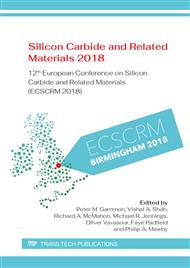p.305
p.309
p.313
p.318
p.324
p.328
p.332
p.336
p.341
Relationship between Temperature Dependencies of Resistivity and Hall Coefficient in Heavily Al-Doped 4H-SiC Epilayers
Abstract:
The temperature dependencies of the resistivity and Hall coefficient for heavily Al-doped 4H-SiC epilayers with Al concentration (CAl) higher than 2×1019 cm-3 were investigated. The signs of measured Hall coefficients (RH) change from positive to negative at low temperatures. For the epilayers with CAl < 3×1019 cm-3 the sign inversion occurred in the hopping conduction region, which was reported to be explicable using the model for amorphous semiconductors. For the epilayers with CAl > 3×1019 cm-3, on the other hand, the sign inversion occurred in the band conduction region, which is a striking feature, because the movement of free holes in the valence band should make RH positive. The sign-inversion temperature increased with increasing CAl, while the dominant-conduction-mechanism-change temperature was almost independent of CAl.
Info:
Periodical:
Pages:
324-327
Citation:
Online since:
July 2019
Price:
Сopyright:
© 2019 Trans Tech Publications Ltd. All Rights Reserved
Share:
Citation:


